Understanding HPMC Detergents A Comprehensive Overview
Hydroxypropyl Methylcellulose (HPMC) is a versatile polymer widely used in various industries, notably in pharmaceuticals, food, and construction. However, one of its most intriguing applications lies in the formulation of detergents and cleaning products. The incorporation of HPMC into detergents enhances their performance significantly, making them a focal point for research and development in the cleaning industry.
What is HPMC?
HPMC is a non-ionic cellulose ether produced from natural cellulose. It is modified through a process that introduces hydroxypropyl and methyl groups into the cellulose structure, enhancing its solubility in water and its ability to form gels. This modification means that HPMC can dissolve in cold water, making it ideal for applications that require stability and performance at varying temperatures.
The Role of HPMC in Detergent Formulations
The incorporation of HPMC in detergent formulations serves multiple functions
1. Thickening Agent HPMC acts as a thickener, providing the desired viscosity to liquid detergents. This is essential for creating a product that is easy to dispense and apply, ensuring a controlled release during use.
2. Stabilizer In suspension-based detergents, HPMC helps to stabilize the formulation by preventing the sedimentation of active ingredients. This stability is crucial for maintaining product efficacy over time.
3. Film Forming HPMC can create a protective film on surfaces during the cleaning process. This film can help enhance the removal of dirt and grime while leaving a smooth finish on surfaces, contributing to the overall cleaning effectiveness.
4. Compatibility HPMC is compatible with various surfactants and other chemical components typically found in cleaning products. This compatibility ensures that HPMC can be integrated smoothly into existing formulations without compromising performance.
5. Eco-Friendly Profile As a cellulose-based polymer, HPMC is biodegradable and possesses a lower environmental impact compared to traditional synthetic thickeners and stabilizers. This aspect aligns well with the growing demand for sustainable and eco-friendly cleaning products.
Advantages of HPMC Detergents
hpmc detergent

The advantages of HPMC in detergent formulations are numerous
- Improved Cleaning Efficiency HPMC enhances the overall cleaning property of detergents, making them more effective in removing stubborn stains and residues.
- Enhanced User Experience The texture and viscosity provided by HPMC contribute to a more user-friendly product, making it easier for consumers to use the detergent without mess.
- Longer Shelf Life By stabilizing the formulation, HPMC extends the shelf life of detergents, allowing products to maintain their efficacy over an extended period.
- Versatility HPMC can be used in various types of detergent formulations, including laundry, dishwashing, and all-purpose cleaners, making it a versatile ingredient within the industry.
Considerations in HPMC Detergent Formulation
While HPMC offers many benefits, formulators must consider a few factors when incorporating it into detergents
- Concentration Levels The concentration of HPMC used can significantly affect performance. Formulators need to optimize the levels to achieve the desired viscosity and cleaning power without compromising the product.
- Interaction with Surfactants While HPMC is generally compatible with various surfactants, it’s crucial to test formulations to ensure that co-interactions do not detrimentally affect the detergent's performance.
- Cost Considerations While HPMC is a naturally derived product, sourcing and incorporating it into formulas can increase production costs. Businesses need to balance efficacy with cost-efficiency to maintain competitive pricing.
Conclusion
In conclusion, HPMC detergents represent a promising innovation in the cleaning product industry, combining environmental sustainability with enhanced performance and user experience. As consumer demand for effective and eco-friendly cleaning solutions increases, the role of HPMC is likely to expand further. Companies invested in cleaning formulations should consider the benefits of HPMC not only for its practical applications but also for its contribution to the creation of sustainable and high-performance products that meet modern consumer needs. With ongoing research and development, the future of HPMC in detergents looks bright, paving the way for more advanced and effective cleaning solutions.
-
Rdp Powder: Key Considerations for Wholesalers in the Building Materials IndustryNewsJul.08,2025
-
Key Considerations for Wholesalers: Navigating the World of Hpmc - Based ProductsNewsJul.08,2025
-
Hpmc Detergent: Key Considerations for WholesalersNewsJul.08,2025
-
Key Considerations for Wholesalers: China Hpmc For Tile Adhesive, Coating Additives, Concrete Additives, and MoreNewsJul.08,2025
-
Crucial Considerations for Wholesalers: Navigating the World of Construction MaterialsNewsJul.08,2025
-
Key Considerations for Wholesalers Sourcing Additive For Cement, Additive For Concrete, Additive For Putty from Additive Manufacturer Shijiazhuang Gaocheng District Yongfeng Cellulose Co., Ltd.NewsJul.08,2025




